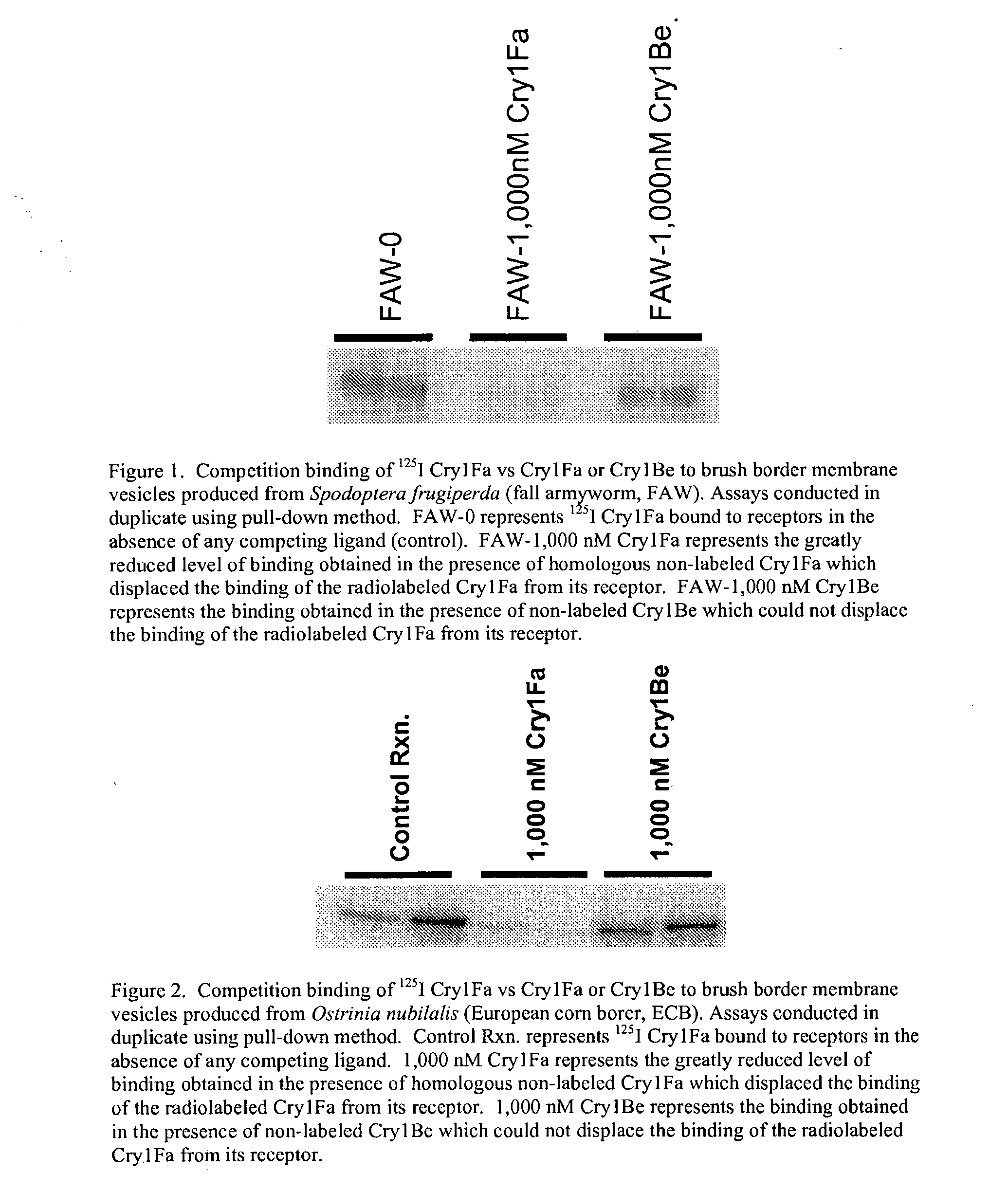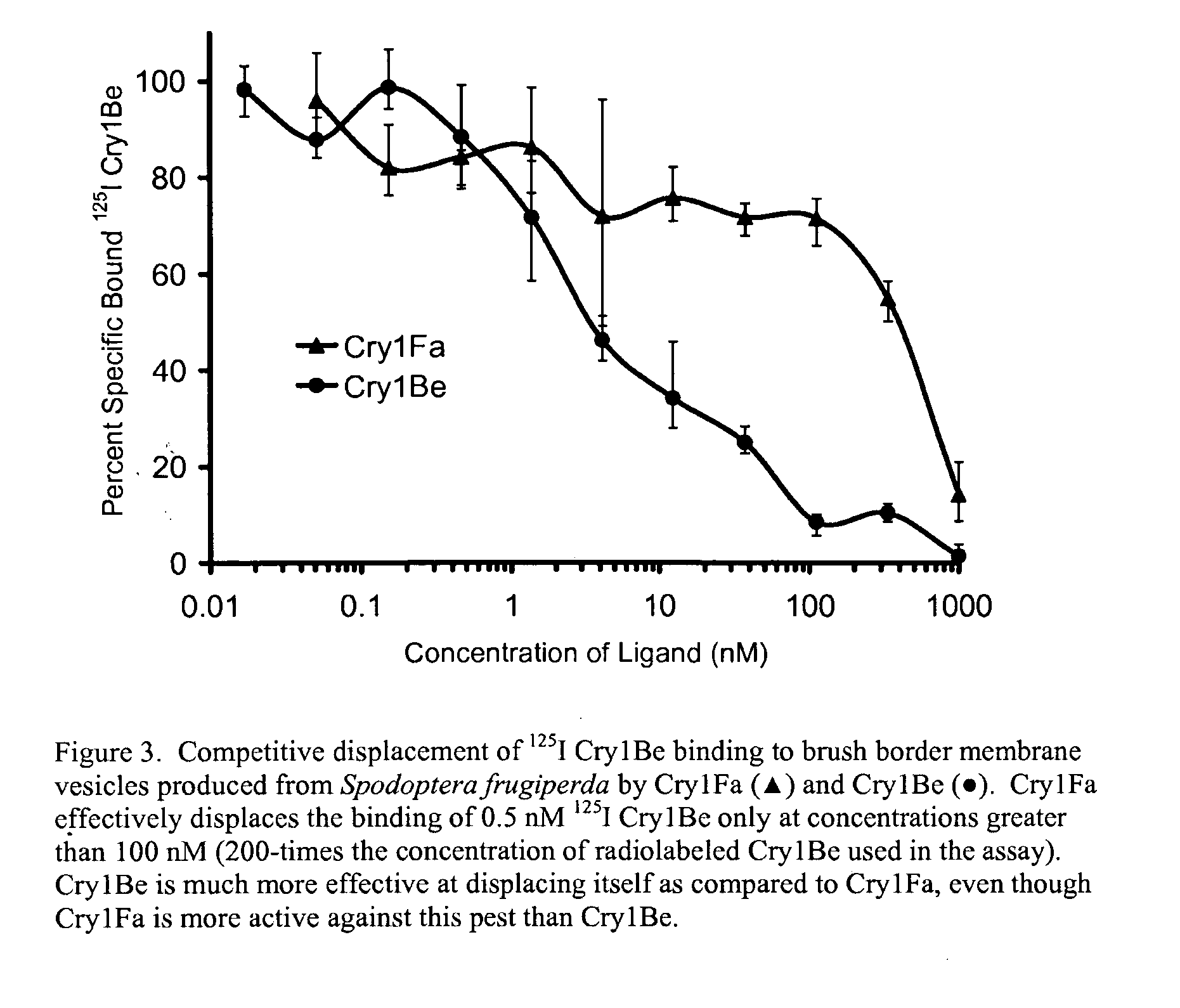Insect resistance management with combinations of cry1be and cry1f proteins
a technology of insect resistance and combination, applied in the field of insect resistance management with combination of cry1be and cry1f proteins, can solve the problems of reducing the effectiveness of protein expression in crops, affecting the survival rate of insects, so as to achieve the effect of less pron
- Summary
- Abstract
- Description
- Claims
- Application Information
AI Technical Summary
Benefits of technology
Problems solved by technology
Method used
Image
Examples
example 1
Bioactivity
[0074]Bioassay results of the subject Cry proteins acting on FAW, ECB, and Cry1Fa resistant FAW and ECB insects are shown in Table 1. Both proteins are highly active against FAW larvae. (For a discussion of this pest, see e.g. Tabashnik, PNAS (2008), vol. 105 no. 49, 19029-19030.) Cry1Fa is much less active against FAW that are resistant towards the toxicity of Cry1Fa (rFAW) as compare to sensitive FAW. Cry1Be is as active, or more active, against rFAW as compared to sensitive FAW.
TABLE 1Table 1. Biological activity of Cry proteins against four differentinsect types, plus Cry1Fa resistant FAW and ECB larvae. Non-underlinedvalues in green are LC-50 values expressed as ranges of valuesobtained from multiple determinations. Underlined values are GI-50 valueswhere the protein does not result in lethality against the particularinsect. Values are in ng / cm2.PRO-TEINCEWFAWrFAWECBrECBBCWCry1Be400-1,0001,000-2,000300600200-1,2002,000Cry1Fa40-120 20-80in-20-100inactive 200active
example 2
Binding Studies
[0075]FIG. 1 shows competition binding of 125I Cry1Fa versus Cry1Fa or Cry1Be to brush border membrane vesicles produced from Spodoptera frugiperda (fall armyworm, FAW). Assays were conducted in duplicate using the pull-down method. FAW-0 represents 125I Cry1Fa bound to receptors in the absence of any competing ligand (control). FAW-1,000 nM Cry1Fa represents the greatly reduced level of binding obtained in the presence of homologous non-labeled Cry1Fa which displaced the binding of the radiolabeled Cry1Fa from its receptor. FAW-1,000 nM Cry1Be represents the binding obtained in the presence of non-labeled Cry1Be which could not displace the binding of the radiolabeled Cry1Fa from its receptor.
[0076]FIG. 2 shows competition binding of 125I Cry1Fa versus Cry1Fa or Cry1Be to brush border membrane vesicles produced from Ostrinia nubilalis (European corn borer, ECB). Assays were conducted in duplicate using the pull-down method. “Control Rxn” represents 125I Cry1Fa bound ...
PUM
| Property | Measurement | Unit |
|---|---|---|
| resistance | aaaaa | aaaaa |
| cross-resistance | aaaaa | aaaaa |
| insect resistance | aaaaa | aaaaa |
Abstract
Description
Claims
Application Information
 Login to View More
Login to View More - R&D
- Intellectual Property
- Life Sciences
- Materials
- Tech Scout
- Unparalleled Data Quality
- Higher Quality Content
- 60% Fewer Hallucinations
Browse by: Latest US Patents, China's latest patents, Technical Efficacy Thesaurus, Application Domain, Technology Topic, Popular Technical Reports.
© 2025 PatSnap. All rights reserved.Legal|Privacy policy|Modern Slavery Act Transparency Statement|Sitemap|About US| Contact US: help@patsnap.com


